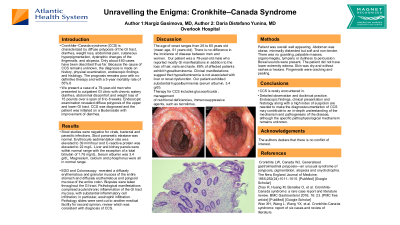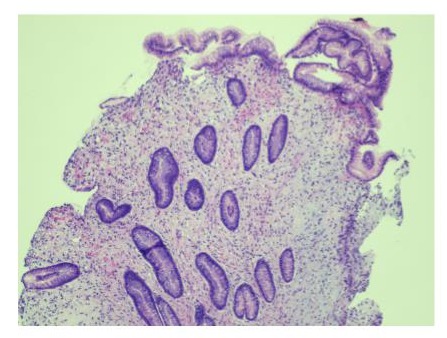Tuesday Poster Session
Category: General Endoscopy
P4125 - Unravelling the Enigma: Cronkhite – Canada Syndrome
Tuesday, October 29, 2024
10:30 AM - 4:00 PM ET
Location: Exhibit Hall E

Has Audio

Nargiz Gasimova, MD
Overlook Hospital
Summit, NJ
Presenting Author(s)
Nargiz Gasimova, MD1, Daria Yunina, MD2, Kathryn Piotti, MD3
1Overlook Hospital, Summit, NJ; 2AMG Gastroenterology, Summit, NJ; 3Morristown Pathology Associates, Summit, NJ
Introduction: Cronkhite–Canada syndrome (CCS) is a rare condition characterized by diffuse gastrointestinal polyposis, diarrhea, weight loss, ectodermal changes which were observed in our case of a 79-year-old man. The diagnosis was confirmed through endoscopic and histological examination. Treatment included corticosteroids which resulted in diarrhea improvement. CCS is challenging to diagnose due to its rarity, unclear etiology, and limited treatment options.
Case Description/Methods: Case Description: A 79-year-old male presented with chronic watery diarrhea (up to 20 episodes daily) and a 15-pound weight loss over 6 to 8 weeks, dystrophic changes of fingernails and hair loss. There was no recent antibiotic use, travel, or unusual ingestions, no sick contacts. Physical examination revealed dry skin, and cracking and peeling fingernails. Laboratory studies showed negative stool tests for infections, normal stool pancreatic elastase, elevated erythrocyte sedimentation rate and C-reactive protein, with hypoalbuminemia. Liver and kidney panels were normal except for total bilirubin. Endoscopy revealed diffuse erythematous and polypoid mucosa in the stomach and colon, with biopsies showing acute and chronic inflammation and eosinophilic infiltration. A diagnosis of Cronkhite–Canada syndrome (CCS) was confirmed by a second pathology review. The patient was treated with 9 mg of oral Budesonide, resulting in complete resolution of diarrhea, and was referred for nutritional evaluation.
Methods: This retrospective case report was based on the patient’s medical records, including clinical presentation, physical examination, laboratory findings, and endoscopic results. Histopathological analysis of gastrointestinal biopsies and an external second opinion confirmed the diagnosis of CCS.
Discussion: Cronkhite–Canada syndrome (CCS) is a rare condition characterized by diffuse gastrointestinal polyposis, diarrhea, weight loss, and ectodermal changes with hypoalbuminemia, which was observed in our case. With only about 450 cases reported, its etiology remains unknown. Diagnosis relies on clinical history, physical examination, endoscopic findings, and histology. Therapeutic options are limited, with glucocorticoids being the primary treatment despite uncertain efficacy. This case underscores the necessity of a high index of suspicion and comprehensive evaluation for effective diagnosis and management of CCS. Further documentation and study are essential to advance understanding and treatment of this rare syndrome.

Disclosures:
Nargiz Gasimova, MD1, Daria Yunina, MD2, Kathryn Piotti, MD3. P4125 - Unravelling the Enigma: Cronkhite – Canada Syndrome, ACG 2024 Annual Scientific Meeting Abstracts. Philadelphia, PA: American College of Gastroenterology.
1Overlook Hospital, Summit, NJ; 2AMG Gastroenterology, Summit, NJ; 3Morristown Pathology Associates, Summit, NJ
Introduction: Cronkhite–Canada syndrome (CCS) is a rare condition characterized by diffuse gastrointestinal polyposis, diarrhea, weight loss, ectodermal changes which were observed in our case of a 79-year-old man. The diagnosis was confirmed through endoscopic and histological examination. Treatment included corticosteroids which resulted in diarrhea improvement. CCS is challenging to diagnose due to its rarity, unclear etiology, and limited treatment options.
Case Description/Methods: Case Description: A 79-year-old male presented with chronic watery diarrhea (up to 20 episodes daily) and a 15-pound weight loss over 6 to 8 weeks, dystrophic changes of fingernails and hair loss. There was no recent antibiotic use, travel, or unusual ingestions, no sick contacts. Physical examination revealed dry skin, and cracking and peeling fingernails. Laboratory studies showed negative stool tests for infections, normal stool pancreatic elastase, elevated erythrocyte sedimentation rate and C-reactive protein, with hypoalbuminemia. Liver and kidney panels were normal except for total bilirubin. Endoscopy revealed diffuse erythematous and polypoid mucosa in the stomach and colon, with biopsies showing acute and chronic inflammation and eosinophilic infiltration. A diagnosis of Cronkhite–Canada syndrome (CCS) was confirmed by a second pathology review. The patient was treated with 9 mg of oral Budesonide, resulting in complete resolution of diarrhea, and was referred for nutritional evaluation.
Methods: This retrospective case report was based on the patient’s medical records, including clinical presentation, physical examination, laboratory findings, and endoscopic results. Histopathological analysis of gastrointestinal biopsies and an external second opinion confirmed the diagnosis of CCS.
Discussion: Cronkhite–Canada syndrome (CCS) is a rare condition characterized by diffuse gastrointestinal polyposis, diarrhea, weight loss, and ectodermal changes with hypoalbuminemia, which was observed in our case. With only about 450 cases reported, its etiology remains unknown. Diagnosis relies on clinical history, physical examination, endoscopic findings, and histology. Therapeutic options are limited, with glucocorticoids being the primary treatment despite uncertain efficacy. This case underscores the necessity of a high index of suspicion and comprehensive evaluation for effective diagnosis and management of CCS. Further documentation and study are essential to advance understanding and treatment of this rare syndrome.

Figure: Gastric antrum
Disclosures:
Nargiz Gasimova indicated no relevant financial relationships.
Daria Yunina indicated no relevant financial relationships.
Kathryn Piotti indicated no relevant financial relationships.
Nargiz Gasimova, MD1, Daria Yunina, MD2, Kathryn Piotti, MD3. P4125 - Unravelling the Enigma: Cronkhite – Canada Syndrome, ACG 2024 Annual Scientific Meeting Abstracts. Philadelphia, PA: American College of Gastroenterology.
